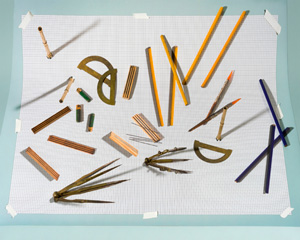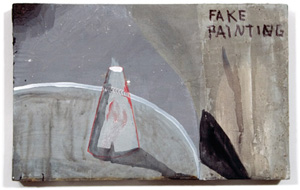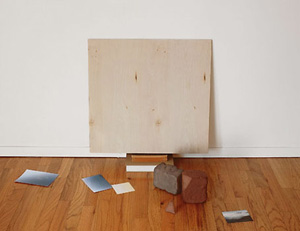The Thing Itself
John Haberin New York City
Michael St. John and Ron Milewicz
John Houck, Mike Womack, and Leslie Hewitt
Realism is supposed to care about reality. What, though, is more realistic—photography, illusion, or the plain sense of things?
Art can still reproduce the sensation of the thing itself. That leaves more choices, though, than you may think. One way is through illusion, but not into deep space. Rather, one can imagine the picture frame as a window onto what lies closest to hand, the wall. And another way is to strip away the illusion. That can still leave the object in its essentials—in the very texture and geometry of the frame, the canvas, the picture plane, and paint. 
Then again, maybe not even paint, not when the boundaries between genres and media these days are fading fast. Michael St. John and Ron Milewicz are painters, with the illusion of photographs or familiar things flush against the wall. John Houck and Mike Womack, though, are not. It just may look that way. Along with Leslie Hewitt, they place things close at hand, but with sculpture and photography, so that literalism itself becomes an illusion. All four also recall another source of realism's staying power—asking one to remember, with seeming scrapbooks of family, culture, personal histories, and race in America.
Headlines and empty overcoats
Forget for now color, anatomy, perspective, and all that. Other notions of realism have little in common with truth to the light, as with Georges Seurat and Seurat drawings or Impressionism, or to space. Another choice is the tradition of trompe l'oeil, leaving art flat against the wall. And another stresses art's material reality, placing even flatness in the room. A photorealist like Philip Pearlstein collapses a composition in three crowded dimensions, to the point that no one would dare to touch. Other artists, though, combine photography and painting in ways that have nothing to do with textbook virtuosity and Mannerism.
Michael St. John takes on illusion, with a nod to John Frederick Peto in post–Civil War America. He also immerses one in a "Cultural Life" for today. Ron Milewicz chooses the second route, with a bare lushness going back to Giorgio Morandi. For Victor Pesce at the same gallery a few months back, objects have the plainness of kitchen counters and popular culture. For Milewicz, things seem ripped out of context, like a loaf of challah bread, spools of thread stuffed in a plastic bag, or bricks without a wall. That just leaves one to determine how much they remember.
This care for immediacy and the picture plane means not having to choose between representation and abstraction, painting and sculpture, or conceptual art and object. St. John piles on appropriation, while making it hard at first to spot what he has appropriated and what he has represented. He has vintage and other photos, a front page, a bra, and the pins and crossed tape right out of Peto to hold them all together. For his one sculpture, he fakes an Anheuser-Busch beer keg in acrylic and plaster, with an ornery toy animal perched on top. Elsewhere JJ Peet has cast a metronome's ornery shadow as Morandi after a night of binge drinking. St. John's gallery has never been all that generous with drinks at openings anyway.
Milewicz, too, remembers America. He calls his show "The Soul Exceeds Its Circumstances," like a blustery Emily Dickinson. He works both with and against his own circumstances, such as gallery walls. An overcoat hangs arms extended and inside out, while a shovel has strokes of rich color, without ever breaking with the genre by becoming impasto. Whose empty overcoat, however, and whose hard labor? He says that he is remembering his father, an Auschwitz survivor who died in 1912.
 St. John recalls the massively framed photographs of Leslie Hewitt, but with painting's deception, and his dark wood belongs to the walls and not the floor. He also shares Hewitt's urban political awareness, but with greater anger and condescension. He rounds up the usual suspects, like the New York Post ("Horror"), Access Hollywood, and Ronald Reagan. He assigns Abe Lincoln the words Ugly Broke Sober, just in case one felt inclined to idealism. And like Milewicz, Mike Womack has in mind his own parents on the other side of the grave. For all their differences, though, they reflect the knowing but freewheeling tone of painting and photography now.
St. John recalls the massively framed photographs of Leslie Hewitt, but with painting's deception, and his dark wood belongs to the walls and not the floor. He also shares Hewitt's urban political awareness, but with greater anger and condescension. He rounds up the usual suspects, like the New York Post ("Horror"), Access Hollywood, and Ronald Reagan. He assigns Abe Lincoln the words Ugly Broke Sober, just in case one felt inclined to idealism. And like Milewicz, Mike Womack has in mind his own parents on the other side of the grave. For all their differences, though, they reflect the knowing but freewheeling tone of painting and photography now.
The "Pictures generation" knew more than to trust the immediacy of images. Now artists are rediscovering them, as uncertain memories. St. John cannot even look back without a politically correct sarcasm, but he is still looking. And Milewicz conveys a visual and tactile sensation unlike all three. He allows one to dwell on the color of crumbling bricks removed from the earth. When smaller canvases hold single leaves, hung Salon style, he might have found life scattered across the wall.
The axis of time
Who knew that graph paper had a history? When John Houck calls his photographs "A History of Graph Paper," he does not even label the horizontal axis to stand for time. For Houck, who also appears in "New Photography 2015" (quite apart from Houck in painting), paper serves as its own data point. The bare grid identifies his sheets of graph paper with formalist painting. With torn envelopes, like those of Jodi Hays in the American South, the distinct lining of each will have to describe its sender in place of an address or a narrative. Yet they tell of their coming together as a photograph, and the process began well before Houck snapped the shutter.
Houck does not seem on the surface to be doctoring things. He composes with graph paper as with everything else—up against the picture plane. A sheet rests in its own envelope on the wall, with no need for Photoshop to suspend it above the ground. It belongs naturally in a studio, if more for a draftsman than a photographer. And Houck devotes an entire photograph to such drafting tools as compasses, protractors, and pencils—and their shadows. Oh, and batteries, for his work also involves software and an inkjet printer.
He speaks of "aggregate photographs," in a process of repetition and aggregation. He saves things, from those weathered tools of Euclidean geometry to the elements of geometric abstraction—or a life. The business cards, I presume, belong to his wife. Houck also creates images from nothing, on computer, and combines them as he sees fit. He cites the actual history of graph paper, in the urge of nineteenth-century science to measure and to quantify. As it happens, the show inaugurates the Lower East Side dealer's spiffy new gallery, a floor above street traffic.
Euclid depends on "one thing after another" anyway, in logical sequence, quite as much as Minimalism for Sol LeWitt. Houck's photographs are in their traditions, as models of reality, reflections of their surroundings, and extensions of who is looking. They also hint at the private life that they refuse to display. In the process, they bury the traces of their own production, but that, too, speaks to the Houck's obsessions. The press release identifies repetition and inquiry with psychotherapy, and I assume that he keeps his studio clean and well-organized. Somebody is sure to disrupt it with further traces all the same.
The show could easily become a lecture in post-structuralism well after it has lost its vigor. (Not that ideas have to depend on fashion.) It helps that Houck really does invoke still life and trompe l'oeil, all while undermining the claim of photography to a science. He may even, for those who like Postmodernism's mind games, fool the eye into seeing photographs as paintings that fool the eye. And he does it without losing the enigma of the personal or, conversely, the clarity of late Modernism. I could use one to solve the other, but then I would need a pencil, an eraser, and graph paper.
One may not think of process painting when it comes to still life. Objects of desire are there to fool the senses, on the way to a moral or a work of art. From the details of this world, painters from as long ago as Jan van Eyck have offered a glimpse of something more lasting. For Jan Vermeer or Jean-Siméon Chardin, drips would be out of place. For Paul Cézanne or Pablo Picasso, a tabletop comes with its own traces, alternatives, and corrections, but to trip up the illusion of a moment in time. Modernism was on its way.
Those who do not remember
George Santayana meant it as a warning, but Mike Womack might disagree. Did Santayana say, "those who do not remember the past are condemned to repeat it?" Womack takes repetition as an imperative, and he thinks that memories are truest before one is even aware of them. If that reminds you of Freud, do not count out today's revived interest in Minimalism. The artist works in polished gray slabs, with echoes of the gallery itself. And he insists that he pays tribute to his late parents, in order to find his own connections to his past. 
If you have trouble making the connections, Womack is here to help. One beam in "Observer Effect" leans against the wall, while others have shelves, pedestals, or thick hanging rope as support. A thinner slab takes much the opposite approach, hiding its base so that it seems to repeat like a tile after Carl Andre, while floating above the floor. Large paper sheets appear to bisect glass or concrete by brute force, while their near blankness reveals nothing. Where Minimalism sometimes spoke of drawing in space, Womack draws with paper itself. He calls the results his "mnemonic mausoleums."
He found inspiration in caring for his ailing mother and her failing memories. Generalizing, he decided that all memories are subject to degradation, and "the safest memories are those in the brain of people who cannot remember." Then he hired a hypnotist to find his. His constructions bear such subtitles as Earliest Memory of My Grandfather, Earliest Memory of Pain, and Earliest Memory of My Own Mortality. If this sounds too weighty for its own good, it should. By now belief in a "recovered memory syndrome" should have run its course, as should quantum mechanics as metaphor for the mind, although I suppose they never will.
Santayana, whose hoary quote appeared in a five-volume tribute to The Life of Reason, might have respected Womack's gravity. The philosopher hoped to explain a "sense of beauty" by the workings of nature and the mind. Something has to happen, though, when the subject of memory moves from history to family. Something happens, too, when pragmatism gives way to art. For one thing, it can get way too concerned for entering the past, as a museum piece. These mausoleums act as Minimalism's period rooms, crossed with the Egyptian pyramid at the Met.
Still, art always brings something concrete to rational speculation. Womack imbues his memories with personal feeling and a physical presence. The clean constructions all but dare one to touch, while the black scrawls on paper tempt one to do the impossible and to read. He falls within the trends of trashing the gallery and deconstructive architecture, but without the clutter or mess. One can also see the disconnect between the artist's statement and the work as self-aware—an expression of the imperfection of filial love and memory. A subtitle like Earliest Memory of Sex even has the luxury of sounding funny.
Womack, too, works some of the same territory as Leslie Hewitt, who dismembers flooring, leans slabs against the walls, or adds thick frames to displace the gallery into memory. Hewitt, for whom paper means photographs of architecture and photographs, has moved up rapidly into since her time as a resident artist at the Studio Museum just five years ago. Maybe that is why her largest and latest seem more dedicated than ever to recovering an African American community, and it supplies a fitting conclusion. The photographs recall the community's roots, in families and students, and its dangers, like a squad car with its lights flashing. One repeated image, of The Fire Next Time by James Baldwin, plainly recalls both. Maybe a black artist, like her or LaToya Ruby Frazier, simply cannot afford to forget the past—or to erect a mausoleum.

Michael St. John ran at Andrea Rosen through October 5, 2013, Ron Milewicz at Elizabeth Harris through October 12, John Houck at On Stellar Rays through October 27, Mike Womack at ZieherSmith through October 5, and Leslie Hewitt at Sikkema Jenkins through October 5. The review of Houck first appeared in a slightly different form in New York Photo Review. A related review looks at John Houck in painting.




